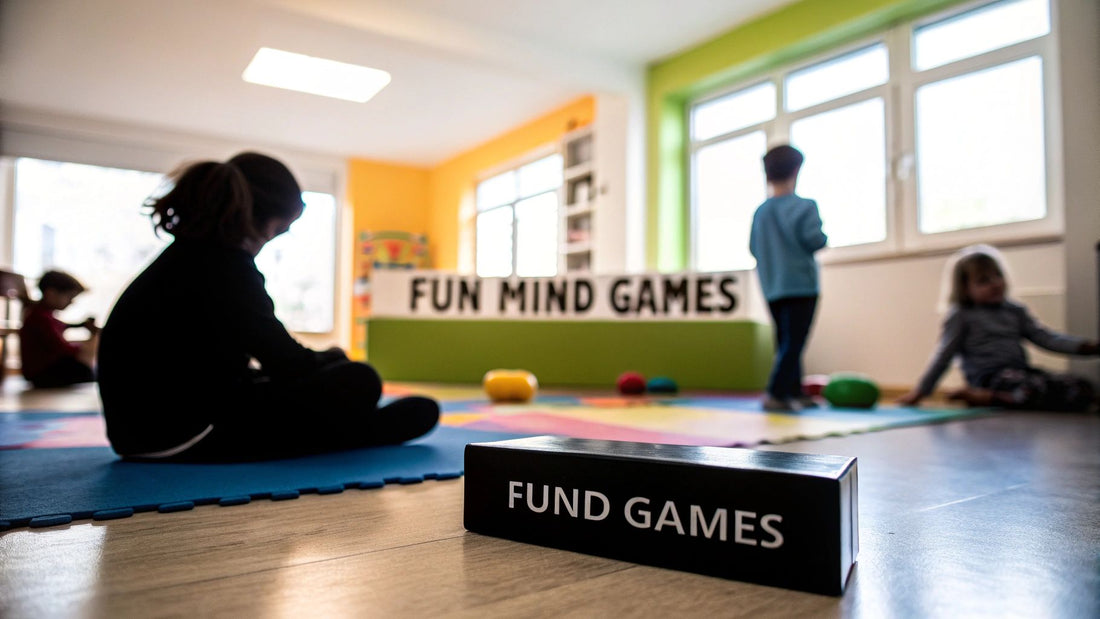
10 Fun Kids Mental Health Activities for 2025
Share
In an increasingly complex world, prioritising our children's mental wellbeing is no longer an optional extra; it's an absolute necessity. The statistics in the UK paint a stark picture: one in five children and young people now have a probable mental health condition. This highlights a growing need for proactive, positive intervention. The constant presence of social media adds another layer of pressure, often impacting self-esteem and creating unrealistic comparisons from a very young age, which can contribute to anxiety and depression.
Addressing these challenges early is crucial. The long-term costs of unaddressed mental health issues are significant, not just for individuals but for society and businesses as well. In the UK, poor mental health costs employers up to £56 billion a year due to absenteeism and lower productivity. Building emotional resilience and coping skills in childhood provides a strong foundation for a healthier, more productive adulthood. This article is designed to be a practical resource for parents, carers, and educators. It provides a curated collection of simple, effective, and fun kids mental health activities that you can integrate into daily life. These exercises, games, and creative projects are designed to help children understand their emotions, build confidence, and develop healthy coping mechanisms.
While these activities are beneficial, it is important to remember that I am not a mental health professional. If you have serious concerns about a child's mental health, please seek advice from a doctor or a qualified practitioner. For those looking for more structured ways to help children focus and regulate their energy, exploring resources on engaging indoor activities for ADHD kids can also provide valuable strategies. Let’s dive into the activities that can make a real difference.
1. Mindfulness and Meditation for Children
Mindfulness is the practice of paying attention to the present moment without judgement. For children, this means learning to notice their thoughts, feelings, and bodily sensations from a place of calm observation. These age-appropriate meditation and mindfulness practices are powerful kids mental health activities that help build emotional regulation skills, reduce anxiety, and improve focus. By guiding children through simple breathing exercises or sensory awareness games, we give them tools to navigate the ups and downs of life.
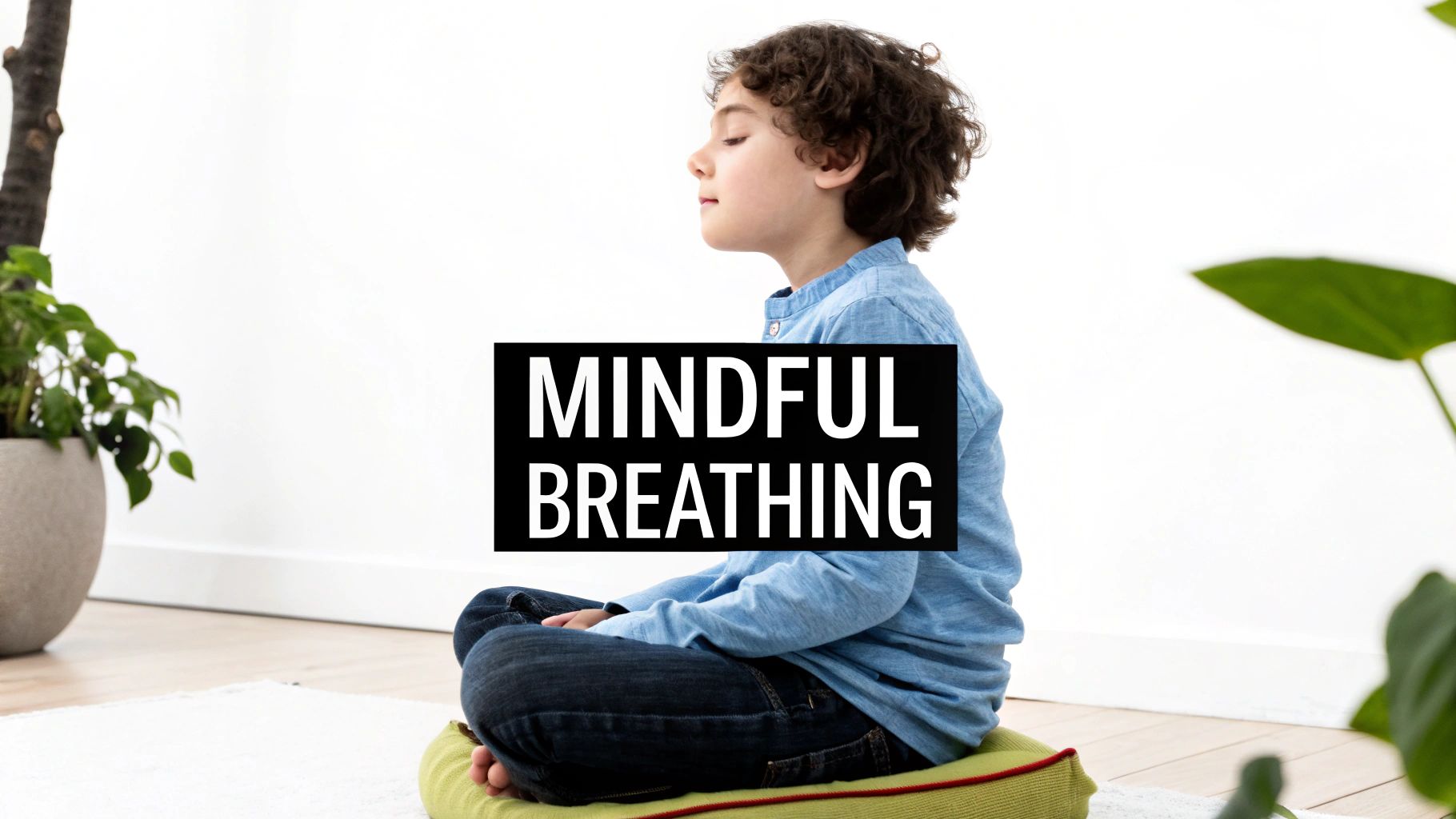
Why It Works
Introducing mindfulness helps children develop self-awareness and control over their reactions. When a child feels overwhelmed by big emotions like anger or sadness, mindfulness techniques offer a healthy way to pause and respond thoughtfully rather than impulsively. This practice has been popularised by pioneers like Jon Kabat-Zinn and Thich Nhat Hanh, and its benefits are supported by programmes like MindUP, which report improved academic performance and reduced aggression in students.
How to Implement It
Getting started is easier than you might think. You don't need special equipment, just a willingness to explore together.
- Start Small: Begin with sessions lasting just 3-5 minutes, especially for younger children. Consistency is more important than duration.
- Use Relatable Metaphors: Explain deep breathing as “smelling a flower” and “blowing out a candle.” A body scan can be a “superhero scanner” checking for energy. For instance, you could say, "Let's use our scanner to check for wiggly feelings in our toes."
- Make It Fun: Turn mindfulness into a game. Try ‘mindful eating’ by slowly exploring the taste, smell, and texture of a single raisin or piece of chocolate.
- Lead by Example: Children learn by watching. Let them see you taking a few deep breaths when you feel stressed. This models healthy coping behaviour.
Key Insight: The goal isn't to clear the mind of all thoughts; it's to teach children to notice their thoughts without getting carried away by them. This builds a foundation for lifelong emotional resilience.
2. Art Therapy and Creative Expression
Art therapy is a powerful way for children to explore and communicate their feelings when words are not enough. Activities like drawing, painting, or sculpting provide a non-verbal outlet, helping children to process complex experiences, from daily frustrations to significant trauma. These creative kids mental health activities are less about artistic skill and more about the therapeutic process of making something, which builds self-esteem, emotional awareness, and essential coping skills in a safe, non-judgemental way.
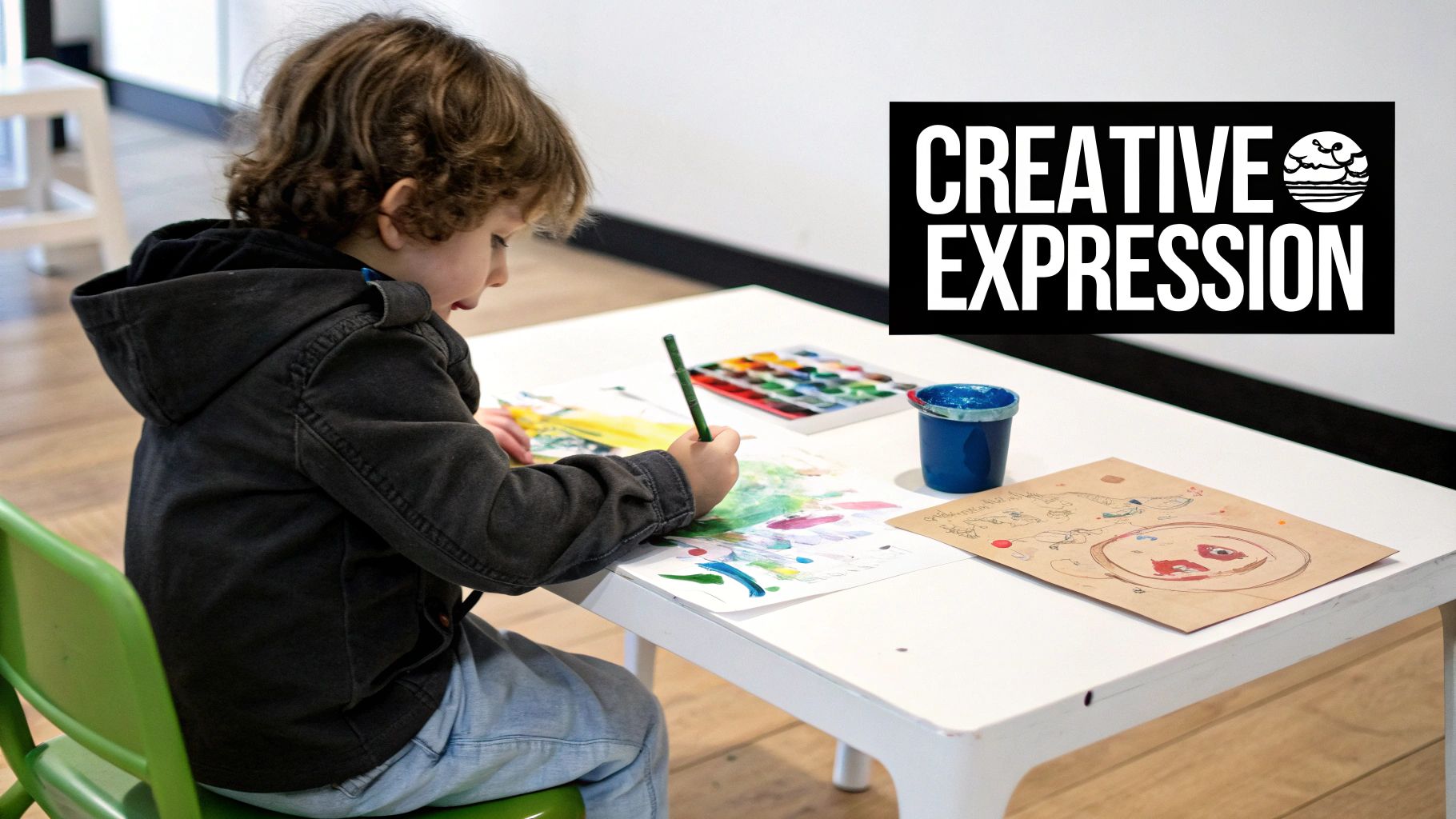
Why It Works
Creative expression allows children to translate internal feelings into a tangible form, giving them a sense of control and understanding. This approach, pioneered by figures like Edith Kramer and Margaret Naumburg, is used effectively in settings like children's hospitals and schools to support recovery and emotional regulation. By externalising their thoughts through colour and shape, children can examine them from a distance, reducing the intensity of emotions like anxiety or anger. Learn more about the power of colouring to express inner feelings.
How to Implement It
You can easily bring the benefits of art therapy into your home with a focus on freedom and exploration rather than perfection.
- Focus on Process, Not Product: Emphasise that there is no right or wrong way to create. The goal is self-expression, not a perfect masterpiece.
- Offer Variety: Provide a range of materials like crayons, paint, clay, and collage supplies. To get started, you can explore some fun and easy art projects for beginners that encourage creativity without pressure.
- Encourage Storytelling: Gently ask your child to tell you about their creation. Questions like, “What is happening in your picture?” can open up conversations about their feelings. For example, you could ask, "Tell me about the colours you chose for this part."
- Create a Judgement-Free Zone: Display their artwork proudly, regardless of the outcome. This reinforces that their feelings and efforts are valid and valued.
Key Insight: Art gives emotions a voice when children cannot find the words. It is a bridge between their inner world and the outside, helping them feel seen, understood, and more in control of their emotional landscape.
3. Play Therapy
Play is the natural language of children. Play therapy is a powerful therapeutic approach that uses this language to help children explore their feelings, make sense of difficult life experiences, and develop positive coping strategies. Unlike adult talk therapy, these guided kids mental health activities allow children to process emotions and trauma through a medium they understand best. A trained therapist creates a safe, accepting environment where toys become the child's words and play becomes their conversation.
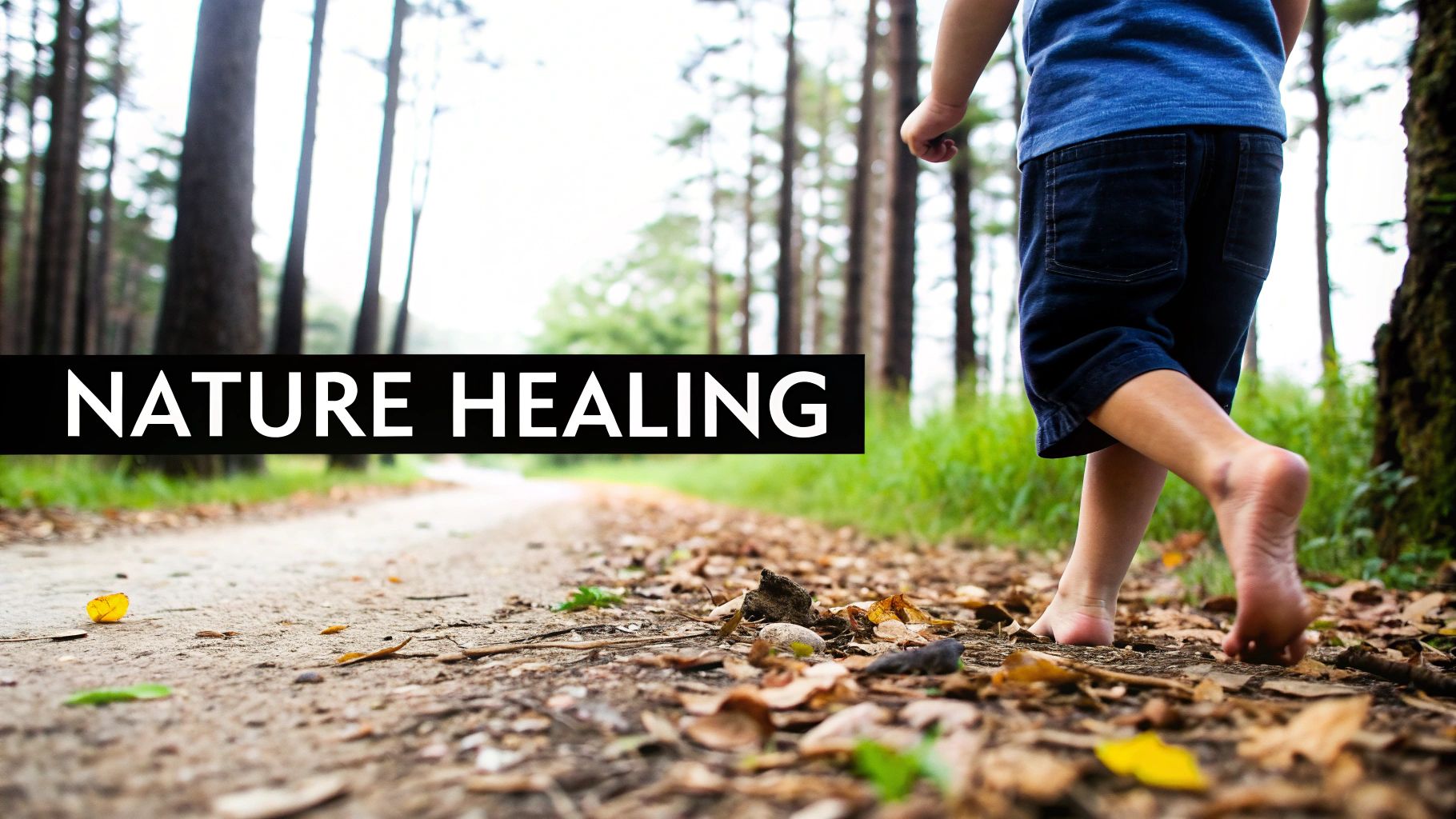
Why It Works
Play therapy gives children a way to express feelings they may not have the vocabulary to articulate. By acting out scenarios with dolls, sand trays, or art supplies, they can confront fears, process events, and regain a sense of control. This approach was pioneered by figures like Virginia Axline and Garry Landreth and is now widely used in various settings, from private practice to school-based support. It is highly effective for addressing behavioural issues, anxiety, grief, and family disruption.
How to Implement It
While formal play therapy requires a qualified professional, parents can adopt its principles to create a more supportive environment at home.
- Follow the Child's Lead: Allow your child to direct the play. Your role is to be an attentive, non-judgemental observer and participant, which builds trust and encourages expression.
- Reflect Feelings: Instead of asking direct questions like "Why are you sad?", reflect the emotion you see in their play. For example, say, "That teddy looks very lonely" or "The dinosaur seems angry." This validates their feelings without pressure.
- Set Gentle Boundaries: While expression is encouraged, it is important to maintain safety. Set clear and consistent limits, such as "It's okay to hit the cushion, but not to hit me."
- Use Expressive Toys: Provide tools like puppets, dress-up clothes, art materials, and dolls that allow for a wide range of emotional and narrative expression.
Key Insight: Play is not just a frivolous activity; it is a child's essential work. By honouring and participating in their play, you create a safe space for them to heal, learn, and build emotional resilience.
4. Journaling and Writing Exercises
Journaling is a powerful way for children to explore their inner world, process complex emotions, and develop self-awareness. These structured and free-form writing activities serve as a private space where kids can express thoughts and feelings they might not be ready to say aloud. As one of the most effective kids mental health activities, journaling helps build crucial communication and emotional literacy skills, providing a tangible tool for reflection and personal growth.
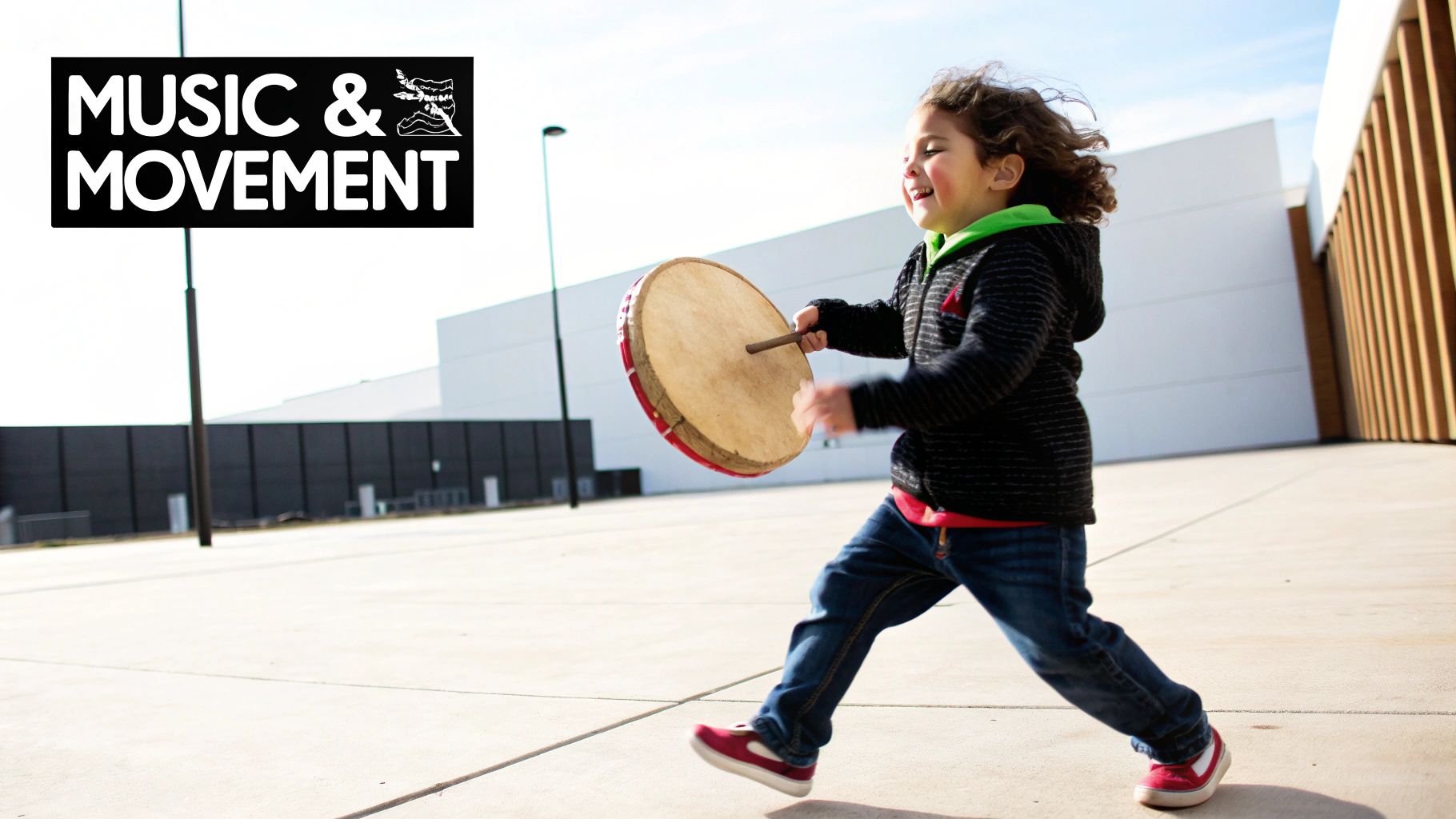
Why It Works
Writing down feelings helps externalise them, making overwhelming emotions feel more manageable. This practice, championed by expressive writing researchers like James Pennebaker, has been shown to reduce stress and improve wellbeing. By creating a habit of reflection, children learn to identify emotional triggers and develop healthier coping mechanisms. It’s a quiet, introspective activity that complements more active, social methods of emotional regulation.
How to Implement It
Encouraging a child to journal should feel like an invitation, not a chore. The key is to make it accessible and enjoyable.
- Start with Simple Prompts: Begin with easy, positive prompts like, “What is one thing that made you smile today?” or “Draw how happiness feels.”
- Combine Drawing and Writing: For younger children, a blank page can be intimidating. Encourage them to draw their feelings first and then write a few words about their picture.
- Respect Their Privacy: A journal is a personal space. Reassure your child that their journal is private and you will not read it without their permission. This builds trust and encourages honesty.
- Model the Behaviour: Let your child see you using a journal or writing down your thoughts. This normalises it as a healthy habit for managing emotions. You can explore more about how to do this by trying this amazing emotions activity with your children.
Key Insight: The purpose of journaling isn't perfect grammar or storytelling; it’s honest expression. It gives children a safe outlet to untangle their thoughts and build a stronger connection with themselves.
5. Deep Breathing and Relaxation Techniques
Deep breathing is one of the most direct and effective kids mental health activities for calming the nervous system. These simple, evidence-based exercises, along with progressive muscle relaxation, help activate the body's natural relaxation response. This process counteracts the physiological effects of stress and anxiety, teaching children a practical skill they can use anywhere to regain control and find a moment of peace. By focusing on their breath, children learn a powerful, portable tool for self-regulation.
Why It Works
When a child is stressed or anxious, their body enters a "fight or flight" mode. Deep, slow breathing sends a signal to the brain to turn on the parasympathetic nervous system, which is responsible for the "rest and digest" state. This lowers the heart rate and blood pressure, creating a sense of calm. Techniques popularised by experts like Dr. Andrew Weil (4-7-8 breathing) and Herbert Benson's research on the relaxation response are now widely adapted for children in therapeutic and educational settings. These exercises are foundational for learning how to manage stress effectively.
How to Implement It
Making relaxation techniques accessible and fun is key to engaging children and encouraging regular practice.
- Make it Visual: Use props like a pinwheel or bubbles. Ask your child to breathe out slowly and steadily to make the pinwheel spin or to blow the biggest bubble.
- Use Playful Imagery: Try "Balloon Breathing." Instruct your child to place their hands on their tummy, imagining it's a balloon they are slowly inflating with each deep breath in and deflating with each breath out. Another is "Lazy Cat Stretch": have them stretch out like a cat waking from a nap, tensing and then relaxing all their muscles.
- Practise When Calm: Introduce these exercises during quiet, happy moments first. This helps them learn the technique without the pressure of being upset, so it becomes an automatic skill they can access during moments of distress.
- Model the Behaviour: Let your child see you take a few deep breaths when you feel frustrated. This demonstrates a healthy coping strategy in a real-world context.
Key Insight: The goal is to give children a tangible physical action they can perform to influence their emotional state. This sense of control is incredibly empowering and builds confidence in their ability to handle big feelings.
6. Nature-Based Activities and Outdoor Therapy
Connecting with the natural world is a deeply restorative practice that offers significant benefits for a child's mental state. Nature-based activities and outdoor therapy involve using natural environments as a therapeutic setting to promote wellbeing. This can range from structured programmes like forest schools to simple, everyday experiences like gardening or a walk in the park. These kids mental health activities leverage the calming and grounding effects of nature to reduce stress, improve mood, and foster a sense of connection.
Why It Works
Exposure to nature helps lower cortisol levels, the body's primary stress hormone, and encourages physical activity, which is a known mood booster. The concept, popularised by Richard Louv in his book Last Child in the Woods and inspired by practices like the Japanese art of Shinrin-yoku (forest bathing), suggests that time outdoors combats the negative effects of excessive screen time. Organisations like the Children & Nature Network advocate for these experiences, pointing to improved concentration and creativity in children who regularly engage with nature.
How to Implement It
Integrating nature into your child's routine doesn't require a trip to the wilderness. Meaningful connections can be forged in a local park, a community garden, or even your own back garden.
- Start Simple: Begin with short, consistent outdoor time. A 15-minute daily walk or time spent sitting under a tree can be a powerful routine.
- Engage All Senses: Encourage your child to notice the sounds of birds, the smell of damp earth after rain, the texture of a leaf, and the sight of sunlight filtering through trees. For example, a nature scavenger hunt can focus on finding something smooth, something rough, and something that smells nice.
- Use Nature Metaphors: Discuss feelings using natural analogies. A deep-rooted tree can represent resilience, while a seed growing represents personal development and potential.
- Embrace All Weather: Provide appropriate clothing and show that nature can be enjoyed in all seasons, teaching adaptability and resilience.
Key Insight: The goal is not just to be in nature, but to interact with it. Fostering this two-way relationship helps children feel part of something larger than themselves, reducing feelings of isolation and anxiety.
7. Social Skills Games and Group Activities
Developing strong social skills is fundamental to a child’s wellbeing, confidence, and ability to form healthy relationships. Social skills games and group activities are structured, playful environments where children can learn and practise essential interactions like sharing, cooperating, reading social cues, and resolving conflicts. These kids mental health activities create a safe, supportive setting for children to build peer relationships and develop empathy, making social learning a positive and engaging experience rather than a source of anxiety.
Why It Works
These activities transform abstract concepts like "being a good friend" into concrete actions. By participating in structured games, children get immediate feedback on their behaviour in a low-stakes environment. This practical application helps them build a toolkit for navigating real-world social situations. Successful frameworks like the Second Step program, developed by the Committee for Children, and Leah Kuypers’ Zones of Regulation are widely used in schools to improve emotional understanding and reduce behavioural issues, demonstrating the profound impact of structured social learning.
How to Implement It
You can easily integrate social skill-building into playdates, family time, or classroom activities. The key is to be intentional and supportive.
- Set Clear Expectations: Before starting a cooperative game or role-play, discuss the rules for respectful communication, such as taking turns to speak and listening without interrupting.
- Start Small: Begin with one-on-one activities or small groups of three to four children. This minimises overstimulation and allows for more focused interaction before moving to larger group settings.
- Model and Reinforce: Actively praise prosocial behaviours like sharing, offering help, or giving a compliment. For example, saying "That was really kind of you to let Tom have a go first" highlights the desired actions.
- Debrief After the Activity: Spend a few minutes talking about what went well and what was challenging. Ask questions like, “How did it feel when we all worked together to build the tower?”
Key Insight: The aim is not to force friendships but to equip children with the confidence and competence to initiate and maintain them. These activities build a foundation of social literacy that supports mental health throughout life.
8. Music and Movement Therapy
Music and movement therapy combines the neurological benefits of music with physical expression to help children process emotions, develop self-regulation skills, and improve social connection. These kids mental health activities use rhythm, melody, and dance to provide a non-verbal outlet for feelings that might be too complex or overwhelming to express with words. This powerful combination helps children synchronise their minds and bodies, leading to greater emotional balance and cognitive function.
Why It Works
This therapeutic approach helps children address emotional and social needs in an engaging, pressure-free way. The structured nature of music can be calming for an anxious mind, while expressive movement allows for the physical release of pent-up energy or stress. Pioneers like the American Music Therapy Association and methods such as the Nordoff-Robbins approach have demonstrated its success in various settings, from community drumming circles for trauma recovery to school-based programmes for students with special needs.
How to Implement It
You don't need to be a trained musician to bring the benefits of music and movement to your child. The key is creating a space for joyful and free expression.
- Focus on Participation: Emphasise fun and involvement over performance quality. The goal is expression, not perfection.
- Offer Variety: Provide a range of simple instruments like shakers, drums, or tambourines to see what your child connects with.
- Use Familiar Songs: Start with songs your child already knows and loves to build comfort and encourage them to join in.
- Incorporate Movement: Encourage dancing, swaying, or marching to the beat. For instance, try "emotion dance," where you play different types of music (fast, slow, dramatic) and ask them to move how the music makes them feel.
Key Insight: Music and movement tap into fundamental brain pathways, offering a direct route to emotional processing that bypasses the need for complex language, making it accessible to children of all ages and abilities.
9. Storytelling and Bibliotherapy
Stories are a powerful way for children to explore complex emotions and situations from a safe distance. Bibliotherapy is the use of carefully chosen books and narratives to help children understand feelings, develop empathy, and build problem-solving skills. These storytelling activities are fantastic kids mental health activities because they allow children to see themselves in characters, normalising their experiences and offering pathways for coping. Whether reading a therapeutic story or creating their own, children can process their inner world.
Why It Works
Narratives provide a framework for making sense of difficult experiences. When a child reads about a character facing a similar challenge, like the separation anxiety addressed in The Invisible String, they feel less alone. This approach, popularised by pioneers like Caroline Shrodes, helps children label emotions and understand others' perspectives. School counsellors often use story time to address issues like bullying, creating a shared language for discussing tough topics. For deeper dives into specific emotional areas, such as developing empathy and navigating social bonds, consider exploring curated lists of books about love and relationships for more ideas.
How to Implement It
Integrating storytelling is both simple and deeply rewarding. It’s about connection, not performance.
- Choose Thoughtfully: Pre-read books to ensure the themes and messages are appropriate for your child's age and emotional needs. Books like The Huge Bag of Worries by Virginia Ironside can be great conversation starters.
- Ask Open-Ended Questions: Prompt discussion with questions like, “How do you think the bear was feeling when that happened?” or “What would you have done?”
- Create Alternative Endings: Encourage your child to imagine and write or draw a different outcome for the story. This builds agency and creative problem-solving.
- Use Props: Bring stories to life with puppets, drawings, or small toys to make the narrative more engaging and memorable.
Key Insight: The magic of bibliotherapy lies in connecting fictional events to a child's real life. It validates their feelings and demonstrates that challenges can be overcome, building a foundation of hope and resilience.
10. Cognitive Behavioural Therapy (CBT) Activities for Kids
Cognitive Behavioural Therapy (CBT) is a powerful psychological approach that helps people understand the connection between their thoughts, feelings, and actions. For children, CBT is adapted into engaging activities that teach them to identify unhelpful thought patterns and replace them with more balanced ones. These kids mental health activities are not about ignoring negative feelings, but about giving children the tools to challenge the thoughts that fuel them, building resilience and healthier coping mechanisms.
Why It Works
CBT empowers children by showing them they have control over their reactions. It operates on the principle that by changing negative thought cycles, a child can change their emotional response and behaviour. This approach has been extensively researched and adapted for young people by pioneers like Aaron Beck, the founder of CBT, and further developed for children through programmes like Philip Kendall’s Coping Cat. These structured exercises help demystify big emotions and provide a clear, actionable framework for managing anxiety and low moods.
How to Implement It
Making CBT concepts accessible requires creativity and a playful approach. The key is to transform therapeutic principles into interactive games and exercises.
- Become a Thought Detective: Encourage your child to "catch" their negative thoughts (or "thought monsters"). Write them down and investigate the evidence for and against them, like a detective solving a case. For example, if the thought is "Nobody likes me," you can investigate by asking, "What happened today that makes you think that? Did anyone smile at you?"
- Use Visual Aids: Create a "thought-feeling-action" triangle on a whiteboard or piece of paper. Use real-life examples to show how a thought ("No one will play with me") leads to a feeling (sadness) and an action (sitting alone).
- Build a Coping Toolkit: Work together to create a physical or digital box filled with personalised coping strategies. This could include breathing exercise cards, a favourite calming song, or a list of trusted adults to talk to.
- Practise During Calm Moments: Introduce these skills when your child is relaxed, not in the middle of a meltdown. This helps the strategies become second nature, making them easier to access during times of stress.
Key Insight: The goal of CBT activities isn't to force positive thinking. It's to foster flexible thinking, teaching children that their first thought isn't always the only or truest one. This builds a foundation for critical self-reflection and emotional agility.
Kids Mental Health Activities Comparison Table
| Approach | Implementation Complexity 🔄 | Resource Requirements ⚡ | Expected Outcomes 📊 | Ideal Use Cases 💡 | Key Advantages ⭐ |
|---|---|---|---|---|---|
| Mindfulness and Meditation for Children | Low to Moderate – simple techniques but needs consistency | Minimal – no special equipment needed | Reduced anxiety, improved emotional regulation, enhanced focus | General emotional regulation, stress reduction, anywhere practice | Easy to adopt, builds resilience, portable |
| Art Therapy and Creative Expression | Moderate – may need trained therapist | Medium to High – materials and possibly therapist | Emotional expression, self-esteem boost, relaxation | Non-verbal emotional expression, trauma processing | Accessible to non-verbal children, process-focused |
| Play Therapy | High – specialised therapist and setup | Moderate to High – play materials, space | Trauma processing, emotional exploration, relationship building | Behavioural issues, trauma, developmental needs | Natural for children, builds therapeutic alliance |
| Journaling and Writing Exercises | Low to Moderate – literacy needed, guidance | Low – journals or digital apps | Emotional vocabulary, self-awareness, communication skills | Emotional processing, self-reflection, literacy support | Private, inexpensive, supports communication |
| Deep Breathing and Relaxation Techniques | Low – straightforward, easy to teach | Minimal – visual aids optional | Immediate stress relief, emotional regulation | Anxiety management, quick calming techniques | Scientifically proven, portable, easy to practice |
| Nature-Based Activities and Outdoor Therapy | Moderate – dependent on environment and supervision | Moderate – access to natural settings necessary | Improved mood, reduced ADHD/anxiety symptoms, confidence | Outdoor engagement, ADHD, mood disorders | Combines physical, sensory, and mental health benefits |
| Social Skills Games and Group Activities | Moderate – requires skilled facilitation | Moderate – group settings and materials | Improved social skills, empathy, communication | Social anxiety, peer relationship building | Builds life skills, peer interaction, empathy |
| Music and Movement Therapy | Moderate to High – may require music therapist | Medium to High – instruments and space | Emotional outlet, mood improvement, motor skills | Emotional expression, motor coordination, cognitive needs | Engages brain and body, creative and non-verbal |
| Storytelling and Bibliotherapy | Low to Moderate – book selection and facilitation | Low – books and props | Empathy development, emotional understanding, imagination | Emotional challenges, empathy, social skills | Safe emotional distance, promotes creativity |
| Cognitive Behavioural Therapy (CBT) Activities for Kids | Moderate to High – conceptual but adaptable | Low to Moderate – worksheets, apps | Emotional regulation, resilience, problem-solving skills | Anxiety, negative thought patterns, emotional regulation | Evidence-based, practical coping skills |
Your Next Steps in Supporting Your Child's Mental Wellbeing
Navigating the landscape of children's mental health can feel complex, but as we've explored, you now have a rich toolkit of practical and engaging strategies at your fingertips. From the quiet focus of mindfulness and journaling to the expressive freedom of art, music, and play, these ten kids mental health activities are more than just ways to pass the time. They are foundational building blocks for emotional resilience, self-awareness, and a lifetime of positive mental wellbeing.
The central takeaway is that supporting your child's mental health is not about waiting for a crisis to emerge. It's about proactively weaving small, consistent practices into your daily life. It’s about creating a home environment where feelings are named, validated, and managed in a healthy way. You don’t need to be an expert to make a profound difference; you just need to be present, patient, and willing to engage.
Turning Knowledge into Action
To truly embed these concepts, consider these actionable next steps:
- Create a 'Wellbeing Schedule': Just as you schedule homework or sports, try to dedicate a small slot each week to a chosen mental health activity. This consistency signals to your child that their emotional wellbeing is a priority.
- Model Healthy Habits: Children learn by watching. Let them see you taking deep breaths when you're stressed, talking about your own feelings, or taking time for a relaxing hobby. Your actions give them permission to do the same.
- Expand Your Resources: Beyond activities, consider how other resources can normalise these conversations. Wearing mental health apparel can be a simple, visual sign of support, sparking curiosity and dialogue. Similarly, integrating thoughtfully chosen mental health books into your reading routine provides relatable characters and scenarios that can help children understand complex emotions.
Remember, the goal is not perfection, but progress. Some activities will resonate more than others, and that’s perfectly fine. The key is to keep the conversation open and the support unwavering. By prioritising these practices, you are giving your child an invaluable gift: the tools to understand their inner world and navigate life's challenges with confidence and strength.
Important Disclaimer: I am not a mental health professional. The information provided in this article is for informational purposes only and is not a substitute for professional medical advice, diagnosis, or treatment. Always seek the help of your GP or another qualified health provider with any questions you may have regarding a medical condition. Never disregard professional medical advice or delay in seeking it because of something you have read in this article. If you are worried about your child's mental health, professional support is the most crucial step.
To continue building your family's mental health library, explore the resources available from Little Fish Books. Their collection of beautifully illustrated books is specifically designed to help children understand and express their feelings in an accessible and engaging way. Visit Little Fish Books to discover stories that can open up important conversations and support your child's emotional journey.
